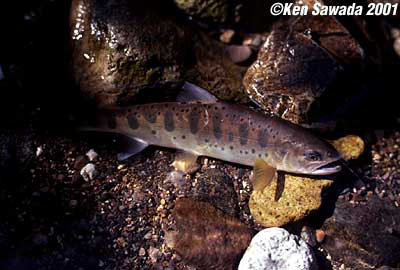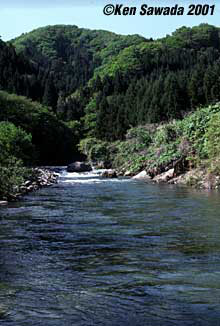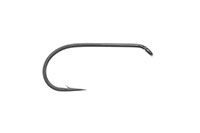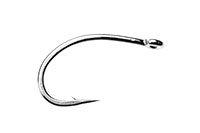
Mountain Streams --Vol.16--
V-cut Hackles
I always cut the lower side of hackles of my dry flies and call that V-cut. That does not mean I cut all of the lower side hackles but cut an angle of 90 degrees in total from a vertical line. Setting the fly upside down, I cut those hackles from their root with scissors. Then “no hackle” part seems V- shape, so I named it V-cut. Needless to say, I cut those hackles in order to get fish’s good response to the dry fly and good hooking probability.
Spent Badger with standard hackles (left) and with V-cut hackles (right).
Yamame Trout in the Mase River
I first tried my V-cut dry fly in the end of 1970’s when I fished up the Mase River in Akita Prefecture in Japan. It was in the end of May. The melting snow season was near to an end and fish in the mountain streams started making rise altogether under the fresh green leaves. In every main fishing point ripples appeared here and there at the same time. It was the heaven for fly fishermen. Everything was going smoothly. Within the first half an hour I caught about 10 char and yamame trout which came up to swallow my dry flies. Farther upstream there were countless circles of rises as far as I could see. I was happy to think how many fish I would be able to catch on that day. It must be a record catch. Given by a rare precious chance, I fished upstream with a light step from one stone to another in high spirit.Near noon, however, something changed. After I caught about 20 fish, I set the hook to no fish clearly much more times. Miserably, I failed in setting the hook to one fish after another. As time went by I missed more and more fish. Finally I gave up fishing upstream but watched the water surface. A yamame trout made a rise in front of me in the slow current. It was that fish which I had just failed in setting the hook to. Although I could not see clearly in my naked eyes, I found small insects drifting on the water surface. Probably fish ate those small insects.

After I devised V-cut hackles I used spinners more often. This yamame trout caught Spent Badger, or I have to say Spent Badger caught it.
I changed size 12 fly into size 14 Spent Badger. At my first casting a yamame trout jumped at the fly and bit it. So it seemed to me. But I could not set the hook to it. I took a deep breath and cast the fly again. When I gazed at the water surface with my eyes wide open, a yamame trout appeared in front of me. But I checked myself and did not lift the rod because I had decided to set the hook to the fish after making sure my fly went out of my sight. Well, my fly is floating and swaying in the ripples that my yamame trout made. I see, my fish has not eaten the fly after all. That reminds me--- fish have somehow appeared in a strange way for a while. I wondered what kept the fish off normal bite. I tried a smaller fly of size 16. But yamame trout in front of me appeared just in the same way and only pricked the small fly lightly as before. Then I was obliged to cast the fly towards another rise 5m upstream. Soon my fly disappeared with a small splash and a yamame trout struggled and came up, splitting the water surface. But my luck did not last. The next fish only pricked my fly. The smaller fly improved the situation a little but something fundamental was still wrong.
I thought over, watching dun that sometimes flew to me and rested on my body. As you know, the fly is not a real insect. But fish jump at the fly, misunderstanding it as a real insect. Actually in the beginning they often jumped at it. But soon they stopped eating it although they still had some concern. Probably because they began to eat dun drifting countless on the water surface. Now what is the difference between dun and my fly put to the leader?

In the end of May char completely regain stamina in the melting snow in the Mase River.
The Fly that Floats just above the Water
Probably the answer is not a tiny factor like fly colour, wing size, or tail number but something fundamental because in most cases I have no problem of catching fish with fly instead of real bait. I have long fancied one factor about fundamental difference between a fly and real bait. That is how the fly is floating, in other words, the posture of the fly floating on the water surface. A real insect, whatever kind it is, has the posture that its whole body touches the water surface with its upward tail while it stays floating on the water. On the other hand, the dry fly with thickly tied hackles has the opposite posture with its breast stuck out, its forefeet stuck out and necessarily its downward tail. As the dry fly can float due to hackles, it is a natural posture. But the difference of posture and proportion on the water surface must put a very different impression on the fish. I wanted to improve the dry fly so that it is floating with its head and breast lower.
Some of my pretty spinners in my fly box apart from two great spinners of Spent Badger and Wild Canary.
(from left to right) Lunn’s Particular, Yellow Boy, Orange Hawk, B.W.O.Spinner and Mase Orange.
(from left to right) Lunn’s Particular, Yellow Boy, Orange Hawk, B.W.O.Spinner and Mase Orange.
Watching the fly carefully, I took scissors from my pocket and cut the breast part of hackles from their root. That part, in other words, hackles just below the fly body, touches the water surface almost at the right angle. If I remove that part, the hackles around there will be forced to curve, which will make the fly floating with its head side lower. At the same time the hook point will not be concealed any more, which will enable better hooking probability. Furthermore, Cutting that part of hackles will ensure the stable posture of fly, which will prevent the fly from rolling on the water surface or prevent the fish from flicking out the fly. Thinking of those things, I cut hackles little by little until no-hackle part was an angle of 90 degrees. Then I cast that fly to a rise.

Yamame trout are very popular among anglers probably not only because they are beautiful but also they play with the fly and make fun of anglers.

The rich stream of the Mase River, where I first devised V-cut hackle. This photo was taken about 1979.
What a pretty fly it is! It looks more real than the real insect. The moment that fly floated on the water I was fascinated with its prettiness without thinking whether it could catch fish or not. My old fly seemed to be reborn into a new creature. Coldness or unnatural element of artificial things completely disappeared from my new fly. I had a feeling that I could catch fish. No sooner had I had some expectation than the fly was put into the fish mouth.
I was beside myself with joy. In every main point fish jumped at my fly. I could not believe they were the same fish as before. I felt as if all the fish in the river intended not to miss any fly drifting to them. After I calmed down later I realized that the way of fly drifting was changed from before. The fly kept such stable posture that it seldom caused the drag. The wind never made the fly slip or turn on the surface any more. When V-cut fly was drifting, it looked like a real insect because not only its style and posture but also its drifting way was similar to a real insect.
Since then I have cut hackles of all flies, especially all spinners in my fly boxes into V- shape.
-- To be continued --
- NET SHOP INFORMATION

SL6 Black Spey Hooks

DU3 Limerick Spinner Hooks

SL4 Single Bartleet Hooks

XD1 Tube Fly Double Hooks

DD2 Flat Perfect Hooks

DD1 Black Terrestrial Hooks

TD4 Old Limerick Wet Hooks

DU1 Silver May Hooks

MU1 Flat Midge Hooks

LD3 Long Limerick Hooks

TD2 Summer Sproat Hooks

XS1 Tube Single Silver Hooks

TD6 Siver Sedge Hooks

SL5 Black Spey Hooks

DU3 Limerick Spinner Hooks
- TROPHY CLUB
- FLY SHOW
- EXHIBITION
- MASTERS`
- FLY DRESSING CONTEST Archives
- TRAVELLER Archives
- TACKLE IMPRESSIONS Archives
- ANGLERS` PHOTO GALLERY Archives
- ----------------------------------------------
- トロフィークラブ
- フライショー
- エキシビション
- マスターズ
- フライドレッシング・コンテスト・アーカイヴ
- トラヴェラー・アーカイヴ
- タックル・インプレッション・アーカイヴ
- アングラーズ・フォトギャラリー・アーカイヴ
株式会社サワダ 185-0021 東京都国分寺市南町3-13-4
SAWADA'S INC. 3-13-4 Minamicho, Kokubunji, Tokyo 185-0021, Japan
写真・ドキュメントの無断転載を禁じます。
All the images and documents found on this site are owned by Ken Sawada and may not be used without permission.
But, link to this site is FREE.
Copyright © 2000 - 2024 SAWADA'S INC.. All rights reserved.
SAWADA'S INC. 3-13-4 Minamicho, Kokubunji, Tokyo 185-0021, Japan
写真・ドキュメントの無断転載を禁じます。
All the images and documents found on this site are owned by Ken Sawada and may not be used without permission.
But, link to this site is FREE.
Copyright © 2000 - 2024 SAWADA'S INC.. All rights reserved.
